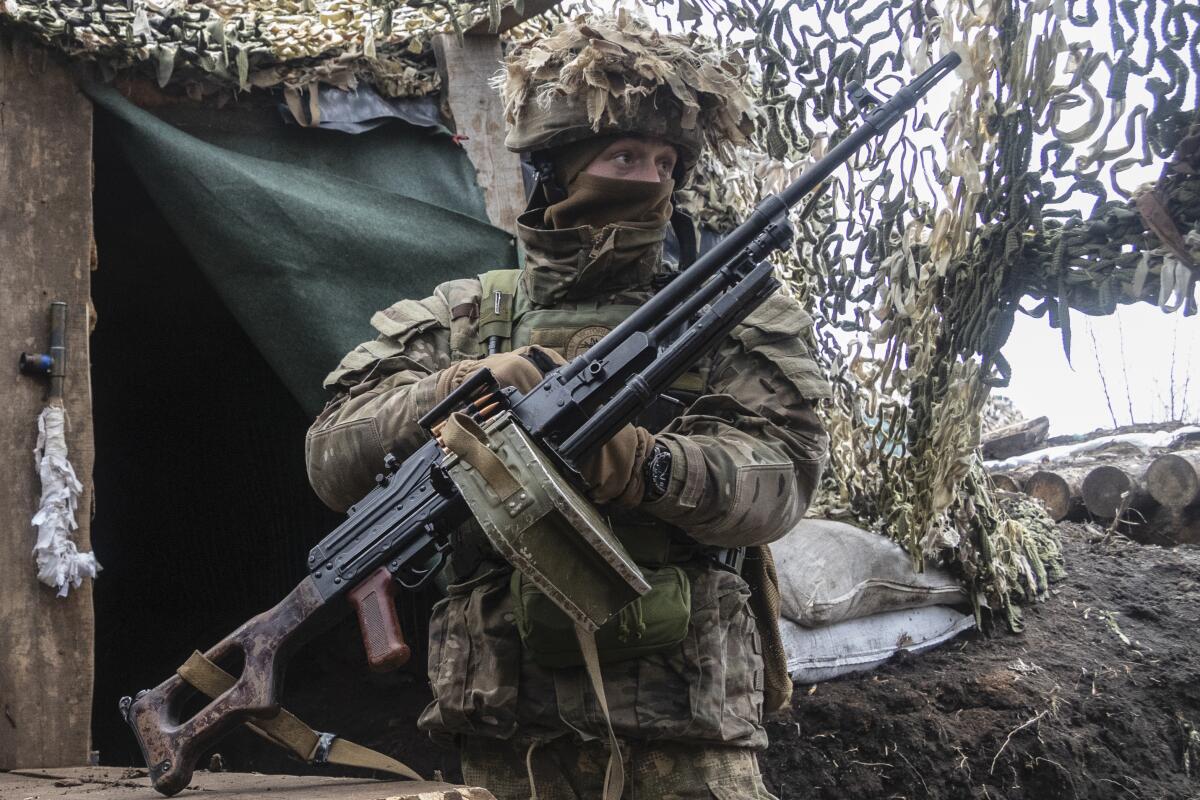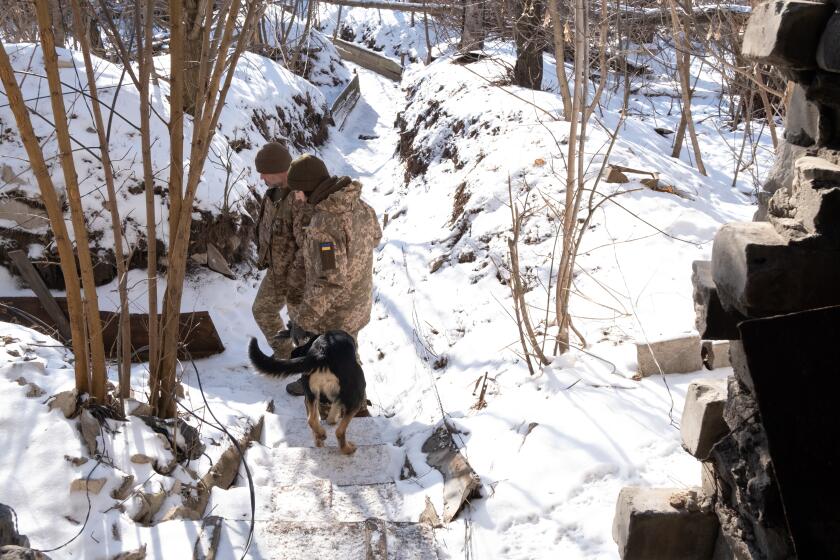Ukraine says a Russian invasion is not imminent, urges citizens to remain calm

- Share via
KYIV, Ukraine — Ukraine’s leaders sought Tuesday to reassure the nation that an invasion from neighboring Russia was not imminent, even as they acknowledged that the threat is real and received a shipment of U.S. military equipment to shore up their defenses.
Russia has denied it is planning an assault, but it has massed an estimated 100,000 troops near the border of Ukraine in recent weeks and is holding military drills at multiple locations in Russia. That has led the United States and its NATO allies to rush to prepare for a possible war.
President Biden told reporters that Russian President Vladimir Putin “continues to build forces along Ukraine’s border,” and an attack “would be the largest invasion since World War II. It would change the world.”
Several rounds of high-stakes diplomacy have failed to yield any breakthroughs, and this week tensions escalated further. NATO said it was bolstering its deterrence in the Baltic Sea region, and the U.S. placed 8,500 troops on higher alert to potentially deploy to Europe as part of an alliance “response force” if necessary. British Prime Minister Boris Johnson also said he was prepared to send troops to protect NATO allies in Europe.
“We have no intention of putting American forces or NATO forces in Ukraine,” Biden said, adding that there would be serious economic consequences for Putin, including personal sanctions, in the event of an invasion.
In a show of European unity in Berlin, German Chancellor Olaf Scholz and French President Emmanuel Macron called for an easing of the crisis.
Scholz said he wanted “clear steps from Russia that will contribute to a de-escalation of the situation.” Macron, who said he would talk with Putin by phone Friday, added: “If there is aggression, there will be retaliation and the cost will be very high.”
The U.S. and its allies have vowed to hit Russia with unprecedented sanctions if Moscow sends its military into Ukraine, but they have provided few details, saying it’s best to keep Putin guessing.
The State Department has ordered the families of all American personnel at the U.S. Embassy in Kyiv to leave Ukraine, and said that nonessential embassy staff could leave as well. Britain said it, too, was withdrawing some diplomats and dependents from its embassy, and families of Canadian diplomatic staff also have been told to leave.
The financial options under consideration to punish President Vladimir Putin if Russia invades Ukraine range from the sweeping to the personal.
Ukrainian authorities, however, have sought to project calm. Speaking in the second televised speech to the nation in as many days, President Volodymyr Zelensky urged Ukrainians not to panic.
“We are strong enough to keep everything under control and derail any attempts at destabilization,” he said.
The decision by the U.S., Britain, Australia, Germany and Canada to withdraw some of their diplomats and dependents from Kyiv “doesn’t necessarily signal an inevitable escalation and is part of a complex diplomatic game,” he said. ”We are working together with our partners as a single team.”
Speaking in the parliament Tuesday, Ukrainian Defense Minister Oleksii Reznikov said that, “as of today, there are no grounds to believe” that Russia is preparing to invade imminently, noting that its troops have not formed what he called a battle group that could force its way across the border.
“Don’t worry — sleep well,” Reznikov said. “No need to have your bags packed.”
In an interview late Monday, however, he acknowledged that “there are risky scenarios” that “are possible and probable in the future.”
Russia has said Western accusations that it is planning an invasion are merely a cover for NATO’s own planned provocations. Kremlin spokesman Dmitry Peskov on Tuesday once again accused the U.S. of “fomenting tensions” over Ukraine, a former Soviet republic with which Russia has been locked in a bitter tug-of-war for almost eight years.
Moscow has rejected Western demands to pull its troops back from areas near Ukraine, saying it will deploy and train them wherever necessary on its territory as a response to what it called “hostile” moves by the U.S. and its allies. Thousands of troops from Russia’s southern and western military districts took part Tuesday in readiness drills in those regions. The maneuvers involved Iskander missiles and dozens of warplanes.
In 2014, following the ouster of a Kremlin-friendly president in Ukraine, Moscow annexed the Crimean peninsula and threw its weight behind a separatist insurgency in the country’s industrial heartland in the east. The fighting between Ukrainian forces and Russia-backed rebels has since killed more than 14,000 people, and efforts to reach a peaceful settlement of the conflict have stalled.
Slog of trench warfare in eastern Ukraine yields scenes reminiscent of World War I.
In the latest standoff, Russia has demanded guarantees from the West that the North Atlantic Treaty Organization would never allow Ukraine to join and that the alliance would curtail other actions, such as stationing troops in former Soviet bloc countries. Some of these demands, such as a pledge to permanently bar Ukraine from membership, are nonstarters for NATO, creating a seemingly intractable stalemate that many fear can end only in war.
Moscow has also accused Ukraine of massing troops near the rebel-controlled regions in the east, with the alleged aim of retaking them by force — accusations Kyiv has rejected.
Analysts say the Ukrainian government is caught between trying to calm its people and ensuring that it gets sufficient assistance from the West in case an invasion does happen.
“Ukrainian authorities are trying to prevent destabilization and panic inside the country — hence the calming statements saying there is no threat of an imminent Russian invasion,” political analyst Volodymyr Fesenko said. “The Kremlin’s plans include undermining the situation inside Ukraine, fomenting hysteria and fear among Ukrainians, and the authorities in Kyiv find it increasingly difficult to contain this snowball.”
Breaking News
Get breaking news, investigations, analysis and more signature journalism from the Los Angeles Times in your inbox.
You may occasionally receive promotional content from the Los Angeles Times.
Kyiv resident Andrey Chekonovsky said Ukrainians have been living with the threat of a Russian attack for eight years, “and I think that the fact that we are worried now is connected with diplomatic games.”
The crisis didn’t stop a large group of people from rallying in front of the parliament in Kyiv, demanding changes to the country’s tax regulations and even clashing with police at one point.
Some residents are, indeed, watching warily.
“Of course we fear Russia’s aggression and a war, which will lead to the further impoverishment of Ukrainians. But we will be forced to fight and defend ourselves,” said Dmytro Ugol, a 46-year-old construction worker in Kyiv. “I am prepared to fight, but my entire family doesn’t want it and lives in tension. Every day the news scares us more and more.”
Putting U.S.-based troops on heightened alert for Europe on Monday suggested diminishing hope in the West that Putin will back away.
The Pentagon said Tuesday it is still identifying the roughly 8,500 U.S. troops being placed on higher alert for possible deployment to Europe, and said that more could be tapped if needed. The U.S. is in “active consultation” with allies about the capabilities they might need, said spokesman John Kirby.
As part of a new $200-million infusion of security assistance directed to Ukraine from the United States, a shipment including equipment and munitions arrived Tuesday in Ukraine, according to Deputy Defense Minister Hanna Maliar.
If Russia invades, “we will provide additional defensive material to the Ukrainians, above and beyond what we have already sent,” U.S. Charge d’Affaires in Ukraine Kristina Kvien said at the airport.
“And let me underscore that Russian soldiers sent to Ukraine at the behest of the Kremlin will face fierce resistance. The losses to Russia will be heavy,” Kvien said.
The U.S. moves are being carried out in tandem with actions by other NATO member governments to bolster a defensive presence in Eastern Europe. Denmark is sending a frigate and F-16 warplanes to Lithuania; Spain is sending four fighter jets to Bulgaria and three ships to the Black Sea to join NATO naval forces; and France stands ready to send troops to Romania.
Biden’s national security team has been working with several European nations, the European Commission and global suppliers on contingency plans if Russia cuts off shipments of oil and natural gas, according to two senior administration officials who briefed reporters about efforts to mitigate spillover effects from potential military action. The officials spoke on condition of anonymity to discuss the deliberations.
If needed, Europe would look to natural gas supplies in North Africa, the Middle East, Asia and the United States. The effort would require “rather smaller volumes from a multitude of sources” to make up for a Russian cutoff, according to one official.
Associated Press writers Ellen Knickmeyer, Lolita Baldor and Aamer Madhani in Washington, Dasha Litvinova and Vladimir Isachenkov in Moscow, Kirsten Grieshaber in Berlin, Barbara Surk in Nice, France, and Sylvia Hui in London contributed to this report.
More to Read
Sign up for Essential California
The most important California stories and recommendations in your inbox every morning.
You may occasionally receive promotional content from the Los Angeles Times.














